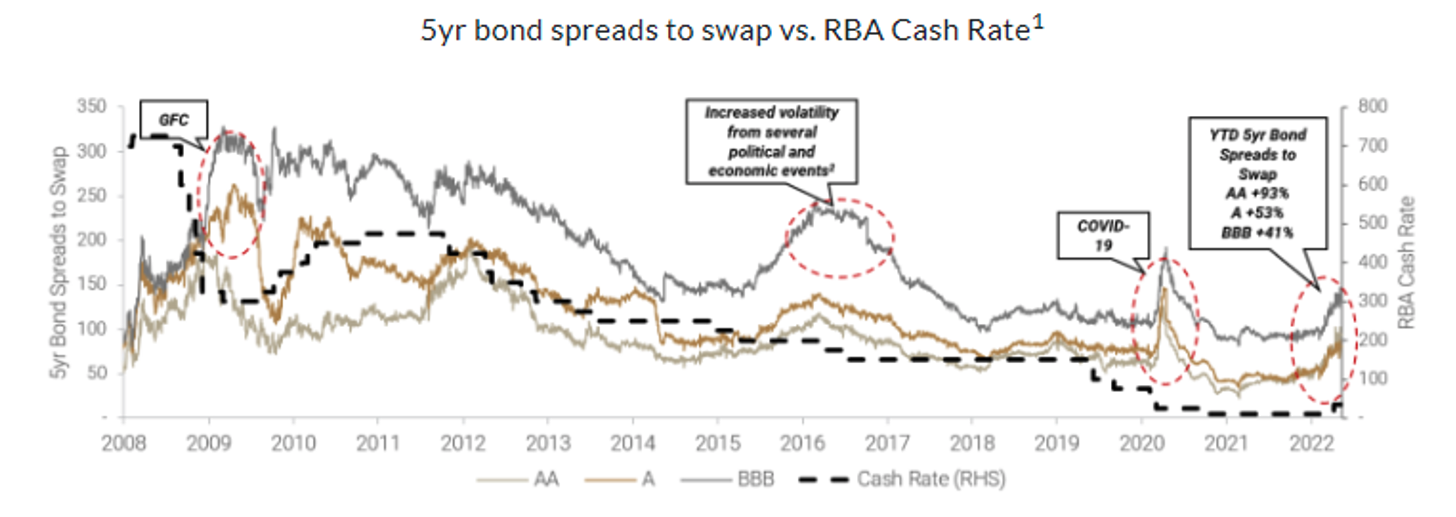A rare marriage of equity-like returns and debt-like security
At the most basic level, if you own a mortgage on a house, the current environment increases your liability. But spin the transaction around to focus on the debt, specifically at the commercial rather than residential level, and you’ve got a defensive asset class where loans are secured by real property mortgages.
“There aren’t many opportunities for investors to achieve equity-like returns with debt-style security, but alternative real estate investment managers offer exactly that,” says Andrew Schwartz, group managing director and co-founder of Qualitas, an alternative real estate investment financier.
CRE debt is a fast-growing asset class that is increasingly accessible to retail investors. In Australia, alternative debt funding currently comprise around 10% of the total market – versus 62% and 53% in the US and Europe and the gap is only widening in Australia.
“Australia will catch up to global counterparts, says Andrew Schwartz. We anticipate non-banks will gain a further 10% market share here in the next decade, which means a further increase of between $40 billion and $50 billion,” Schwartz says.
In the following interview, part of Livewire’s Alternatives in Focus series, Schwartz explains how CRE debt performs in periods of rising rates (spoiler alert: he says it’s a direct beneficiary). He also details the Qualitas process of selecting the right deals for its loan book, the importance of knowing your market, and which parts of the credit spectrum are currently most appealing.
Schwartz also discusses two parts of the commercial property space he believes are most resilient to rising inflation.

What is commercial real estate debt and where does it fit within a retail investment portfolio?
Commercial real estate (CRE) debt refers to loans made to commercial borrowers who need funding for real estate purposes. All CRE loans are secured by real property mortgages. The borrowers are typically wholesale property investors, private corporations, developers, or high net worth individuals. CRE loans are distinct from home loans made to individuals.
CRE loans can be used to purchase land that is vacant and destined for development, developable or improved (with buildings, utilities, or other services), or property (buildings that are complete or under construction). The land or property is the mortgage collateral (or security) for the loan, and investors earn income from the ongoing loan interest and fees.
CRE debt provides portfolio diversification into an asset class that was previously inaccessible to the retail investor. The asset class is a defensive investment with loans secured by real property mortgages. These provide a lower risk of entry compared to outright ownership of property, while pre-agreed loan interest rates have the potential to produce reliable, risk-adjusted returns.
How do you identify opportunities in your space – and what are some of the red flags to watch out for?
With a long-term focus, the average length of our relationships with our top 10 counterparties (by transaction volume) is seven years. Since the IPO of Qualitas late last year, we have experienced increased profile and expansion in deployment pipelines. All our opportunities are evaluated through our disciplined credit risk process, which involves assessing:
borrower quality,
property quality, and
market conditions.
When building a debt portfolio, the loan to value ratios (LVR or LVT) are crucial. Typically, with commercial property, loan-to-value ratios are between 50% and 70%.
It’s also important to assess whether the loan portfolio is weighted towards senior debt (longer duration loans) or mezzanine debt (lower priority than senior debt with higher returns). A stronger focus on senior debt provides security and allows for prioritised repayment if something goes wrong.
Geographic diversification is also key, but you must understand the geographic location of the portfolio in which you're investing. Key questions to ask are:
- Is it all weighted towards a particular city?
- Are they in an overseas country?
- How are sectors performing in that region?
It’s usually best to have a portfolio focused on major Australian capital cities and suburbs that are densely populated.
Another key point is tenor, short-dated tenors now are quite important. In the rising interest rate market, shorter-dated loans allow you to reset the loan if required. Once a fixed interest rate loan matures, you can refinance it to a floating rate loan. Therefore, the interest rate rise would be passed on directly to the borrower.
Short-dated tenors also allow the financiers to revalue the property in a rising interest rate market frequently because – while rising interest rates don't have much an impact on lenders as you simply earn more interest – it may have an impact on property values.
Our investment approach is designed to help ensure a strong and scalable approach to the underwriting of investment opportunities and managing risk. Our equity skillset also brings a unique and beneficial lens to our due diligence as a lender, which is reflected in our track record of no loss of investor capital since our inception 14 years ago.
What are some examples of loans where you’ve had to intervene or that didn’t proceed as expected?
We provided the finance for a specific construction project in one of the northern suburbs of Melbourne, but unfortunately, the builder became insolvent in the project’s early stages. Using a collaborative process, the borrower quickly appointed a new builder and construction resumed within six months. Our senior debt facility had a LVR of less than 70%. When this occurred, pre-sales covered 100% of the senior debt position. This gave us more comfort to fund the increased project costs and also help cover the costs of appointing a new builder and extend purchaser sunset dates, which were shared 50/50 with the mezzanine financier. Ultimately, we incurred no loss of capital, and all interests were paid at the end of the project.
There are a few similar examples where we were involved early. It is important to highlight that we conduct asset reviews on regular basis, which enable us to rapidly identify these situations.
For construction loans, there are multiple layers of equity buffers, including:
- developer and builder contingency,
- developer and builder profit and equity,
- performance bonds from builders, and
- personal guarantees from developers
We also have buffer built-in when making the investment, to allow for up to six months of project delay due to any cost overrun and builder issues.
What are the key lessons you’ve learned from market downturns that have occurred since Qualitas was founded in 2008?
Uncertainty is unavoidable and you always need a way of dealing with it. In considering loans, we always assess three exit paths from the loan. These are:
- a primary exit (normally through cash flow. For example, the sale of the building),
- a secondary exit (being refinance), and
- a tertiary exit (which can be through an enforcement and mortgagee-appointed sale).
It’s important to understand the risks associated with all three pathways and satisfy yourself that these routes exist. We also work to a four-pillar policy that involves:
- the quantification or returns,
- timing or exit,
- risk identification, and
- associated risk mitigants.
These form the basis of our internal risk papers, which are heavily scrutinised.
How does private credit perform during periods of rising inflation, and how do the recent interest rate increases affect the asset class?
What investors need now is shelter from inflation – and that means yields or total returns of more than 5% as a hedge against rising prices in the economy. Property – both equity and especially debt – can deliver those returns and that protection if you know where, and what, to look for.
CRE debt hedges against rising interest rates and inflation. It is well known that debt is considered a safe haven in uncertain environments, particularly senior debt. It is a particularly good time for private debt funds, which are able to benefit from rising base rates and reprice risk margins to the benefit of the funds and their investors.
In terms of base rates, much of our debt book is based on variable rates that will rise in line with official rates. In this way, contrary to the cliché that higher rates are bad for property, they can materially increase returns to our funds and investors with an immediate flow-through effect. Any new loans or roll-overs will be priced on a variable rate base rate.
Risk premiums, represented as margins over base rates, are already rising in line with the uncertainty in the market. As fund flows between the RBA and the banks are withdrawn, the cost of capital is rising, and liquidity is flowing out of the system. This means those with liquidity are demanding greater risk premiums to compensate (see chart). And among those with liquidity in the current market are the alternative non-bank lenders.

Rising rates directly translate to potentially higher returns for commercial real estate debt with the asset class also benefiting from embedded downside protection via borrower equity that takes the first loss on asset value reductions.
There aren’t many opportunities for investors to achieve equity-like returns with debt-style security, but alternative real estate investment managers offer exactly that.
Which real estate sub-sectors (retail, office, industrial) will be most resilient to rising inflation and why?
We have had confidence in the multi-dwelling residential sector ever since the inception of the firm. Australia’s growth is driven by immigration and population growth and these people need somewhere to live – especially now.
Anyone looking for a rental are likely aware that national vacancy is running at a historical low of 1%. Multi-dwelling rental growth rates are well in excess of inflation. Units haven’t had the same level of growth as houses in the last few years and the difference in valuation has widened. Driven by a long-term supply shortage, we expect to see more demand for multi-dwelling residential assets.
The industrial sector has remained resilient driven by structural demand with the shift away from in-store retail fuelling warehouse demand from increased online retail activity.
How big do you expect the Australian private credit market could be in the next few years?
In December quarter last year, there was $19.6 billion worth of commercial properties traded in Australia, and most of those transactions will need to be funded somewhere.
While the CRE debt market is growing at between 2% and 5% annually, the market share of non-banks is also growing at a faster pace. Currently, alternative lenders own $45 billion of the market, or 10% market share, which has risen from 6% about six years ago. For every 1% of market share that alternative financiers pick up from here, that’s more than $4 billion of capital going into the segment.
It’s about industry maturity, and Australia will catch up to global counterparts.
There is a structural and permanent shift in bank lending appetite because of increased APRA regulation, Basel III, and government oversight. Alternative lenders continue to gain market share to fill the funding gap left by banks and to meet increasing borrower demand for flexible financing for which borrowers are willing to pay a premium.
Specialists at creating real opportunities
We are alternative real estate experts who invest across the capital structure and risk spectrum, using institutional and private capital to support our high-quality, commercial real estate partners. Our deep expertise and long-standing relationships have enabled us to build a robust pipeline of growth opportunities for our investors. Click here to find out more.

3 topics
1 stock mentioned
1 fund mentioned
1 contributor mentioned


